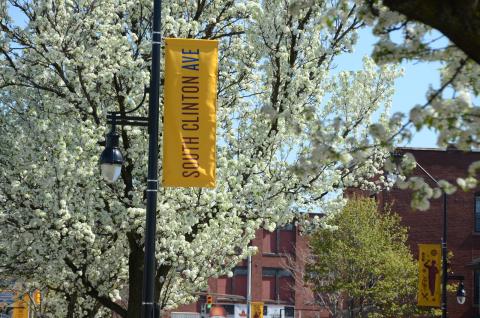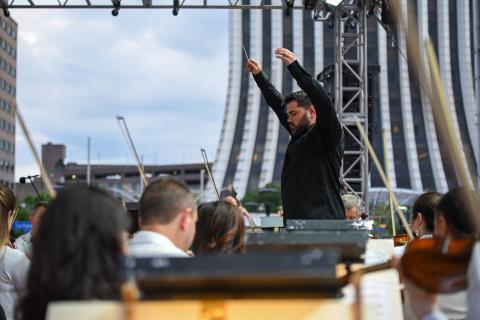The Promenade at Erie Harbor

The Promenade at Erie Harbor refers to the public promenade that the City of Rochester is constructing along the east side of the Johnson-Seymour Mill Race, within the area referred to as Erie Harbor Park. The Erie Harbor Park site is a compact urban park located on a riverfront site adjacent to South Avenue on the east side of the Genesee River, opposite Woodbury Boulevard. The park area is flanked by private land, businesses and New York State owned property. The City has a variety of permits and easements to access the site, including a permanent easement through the site to provide public access to the river front. It is these areas that the City is working to drastically improve public access to the astounding views of the Genesee River, Court Street Dam, the historic Court Street Bridge and the historic Lehigh Valley Railroad Passenger Station (occupied by Dinosaur BBQ).
A multi-use promenade and pedestrian bridge connection to Court Street will serve as a community connector, a trail connector for the Genesee Riverway Trail, and a connection to the Rochester region’s history. The promenade and bridge will fill a missing link in the Genesee Riverway Trail, a designated National Recreation Trail, with connections to downtown, neighborhoods, and regional and state-wide trails.
About the project
In 2009, the City received a matching grant from the New York State Department of State (with funds provided under Title 11 of the Environmental Protection Fund) to conduct planning and preliminary design for this important site. The resulting study created a vision for the currently underutilized Erie Harbor Park site and showcased its potential to be a tremendously valuable community asset. For all the details, download the full Master Plan. Subsequently, the report resulted in the formation of a phased implementation plan for public improvements. In 2011, the City received a second matching grant from NYS for final design and creation of final bid documents construction of The Promenade at Erie Harbor and related features.
Building upon a site with a significant local history
The area that we refer to as Erie Harbor Park flanks the Johnson-Seymour Raceway, a mill race located on the east bank of the Genesee River in the heart of downtown Rochester. The raceway dates back to the early 1800s and continues to function today as the primary source of cool water for the Central Library's air conditioning. This mill race was one of the first private capital works undertaken in Monroe County, and dates back to 1817 when it was opened by Elisha Johnson to serve his milling operations. A dam that predates the current Court Street Dam allowed water to flow into the Johnson-Seymour Raceway from the Genesee River. By 1820, an oil mill, saw mill, paper mill and flower mill could be found along the race, and by 1855, there were at least six flour mills using water power from the race. The Rochester, Fitzhugh, and Carroll Raceway on the west bank of the river mirrored the Johnson-Seymour, but has since been filled in, making the Johnson-Seymour the only remaining raceway from Rochester’s early industrial days that still flows in downtown.
Several man-made structures can be found on the site, all of which are relics of Rochester’s transportation past. Stone piers located in the raceway once held an elevated train track that served the Lehigh Valley Railroad passenger station. The tracks are long gone, but the passenger station is still in existence. A portion of an elevated street, once called Harbor Boulevard, is also a prominent site feature, however, it is in poor condition and in various stages of deterioration. Remnants of the old Court Street Station subway platform is also still visible, though the Rochester Subway has been defunct since 1956.
The Genesee River defines the western boundary of the site, Court Street to the north, South Avenue to the East, and a prominent feature to the south of the site is the circular on-ramp to I-490 east.
Erie Harbor project goals
The goals set forth for overall Erie Harbor improvements were established by the City and confirmed and/or enhanced during the public process, which included two public meetings. The goals were used throughout the project when creating initial concepts, evaluating them and ultimately getting to a preferred alternative. They are:
- Enhance the Erie Harbor public open space and waterfront.
- Improve access from South Avenue and Woodbury Boulevard to accommodate safer pedestrian and potential vehicular access to the site.
- Extend the Genesee Riverway Trail along the site’s waterfront to promote increased utilization of the public waterfront and the larger regional trail network.
- Provide park signage, trail way-finding, and explore interpretive opportunities to educate the public of the site’s industrial history.
- Explore the potential for a portion of the site to yield a mixed-use development that incorporates commercial and retail uses.
- Consider the goals outlined in the master plan for Rochester’s Historic Canal District which include the potential to re-water the original course of the Erie Canal which ran through downtown, including the Erie Harbor site.
The plan
Phase I focused on cleaning up the site to prepare it for future phases and generally increase the visibility of the historic raceway, and extend the trail system, all at a relatively low cost. Phase I work included:
- Replacement of chain link fence
- Lawn seeding and tree planting
- Park lighting
- Extending and expanding the Genesee Riverway Trail
- Construction of utility access drives to protect the remainder of the site
Phase II included:
- Construction of a 20-ft. wide pedestrian promenade with cantilevered overlooks
- Construction of a 200-ft. long pedestrian bridge
- Reconstruction and preservation of the circa-1815 Johnson-Seymour Raceway
- Public amenities consisting of benches, signage, historic interpretation, lighting, landscaping and various gateway features
- Re-alignment and enchancement of the Genesee Riverway Trail
Public meeting
A public informational meeting was held on Nov. 30, 2015 in the Kate Gleason Auditorium at the Central Library.






